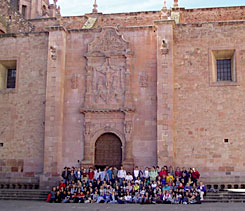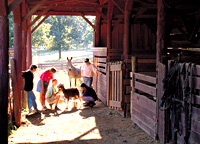Border Crossing: The International School of the Americas Makes a Connection
How one school opens minds by leaving the country.
Your content has been saved!
Go to My Saved Content.
As teachers, we are great at delivering important facts and thought-provoking statistics. But nothing beats firsthand experience to open the mind and expand the heart.
Just a few weeks after I began teaching sophomore world history at the International School of the Americas (ISA), in San Antonio, Texas, I boarded a plane to Mexico City with twelve students and two other teachers. Although the Mexican border is just 150 miles away, it was, for many of us travelers, our first trip outside the United States. Our group spent several days exploring the people and culture of a country that, just a few hours south of our city, felt like a world away.
That weeklong expedition (now nearly eight years ago) convinced me that travel adds depth and meaning to our studies and helps students begin to see themselves as citizens of the world. Often these trips also serve as the catalyst for reflection on issues of family and self. For example, during a trip to Zacatecas two years ago, the past and present converged in a profoundly personal way for one sophomore. Riding on the bus through the desert, she wrote this diary entry:
I looked out my window at the horizon, the parched ground, the dusty shrubs, and the overwhelming mountains. I thought about how totally hot it was and how it would really stink to be outside. Then it really hit me -- my family. This is where [my ancestors] were. In the 1800s [they] came to the United States -- that's all I know. Now I see how they must have suffered [to get there]. They didn't have roads, they must have suffered in the heat, no food, no water, many must have died and I don't even know their names. They made this great sacrifice for me, they walked through the desert, they wanted a better life for their children and I don't even know their names.
A Tall Order:
The bell tower of the colonial baroque structure.
Credit: International School of the AmericasCitizens of the World
Founded in 1994 through a collaboration between Trinity University and the North East Independent School District, ISA is a public magnet school that offers students a rigorous traditional high school curriculum with a decidedly nontraditional focus on global education. Our small size -- just 460 students -- enables our thirty-two teachers and administrators and nine interns from Trinity to provide each student with the individual attention needed to thrive, inside and outside the classroom.
From the day we opened our doors, our mission has been clear: to challenge students and staff to consistently reflect upon and question what it means to be a global citizen. We expect students and teachers to use their education to improve themselves, their school, and their local and global community. These beliefs are stronger and more important today, given the current tense international climate, than they were when the school opened eleven years ago.
MULTIMEDIA: International School of the Americas
Travel -- to other areas of Texas, other regions in the United States and Mexico, and other destinations -- is an integral part of the ISA experience. During our memorable first trip to Mexico, for instance, our small group explored everything from the public and private school systems to Diego Rivera's powerful and culturally enlightening murals. We hiked to the top of the Pyramid of the Sun and Moon at Teotihuacan, explored the ruins of Tlaxcala to observe the blending of Mesoamerican myth through the ages, and passed through the churches of Cholula to prepare for a discussion about assimilation and religious syncretism.
With each new venue we visited, places and ideas that we had studied came alive. The trip was so successful that it inspired us to design a tenth-grade trip to Zacatecas, in the interior of Mexico, that is now part of our regular curriculum. This trip serves as the culmination of an interdisciplinary unit in which students examine the meaning of identity on a personal, municipal, and national level. They participate in local and international expeditions that explore culture, politics, history, industry, civic planning, religion, and art, and they use the trip to examine the connections and comparisons between life in the colonial Mexican city and in San Antonio.
Pet Project:
After participating in the Heifer program, many students encourage their parents to purchase an animal for a needy family or village.
Credit: Heifer InternationalGlobal Village People
We also want to expand on the students' budding international awareness. So each fall the entire freshman class travels to the headquarters of Heifer International, a nonprofit organization outside Little Rock, Arkansas, that is dedicated to ending world hunger and poverty. While at Heifer, students participate in a global village simulation in which they learn about the unequal distribution of worldwide resources, principles of sustainable development, and life in the developing world. They are also introduced to Heifer's attempts to help people living in developing countries.
Since our freshmen take biology and world geography, the learning is authentic, interdisciplinary, and connected to previous and future studies. Each student is assigned a socioeconomic level and a country or region of the world (such as Uganda, Guatemala, Appalachia, Tibet, or a large urban slum). Some students are designated as refugees and must seek asylum, as well as the assistance of other global villagers. They live in structures authentic to that area of the world and experience the challenges of economic need. Each "family" of students is given different resources, such as firewood, matches, water, and food, to use themselves or to barter for provisions for an evening meal.
The experience engages the students' minds and hearts, while it fosters an emotional understanding of hunger and a glimpse of life in the developing world. They realize that while they had to deal with depravation only temporarily, for others it's a constant problem. The students also become articulate about what the overall experience means, coming away with not only general questions like, What can I do to help? but also specific ones like, What should I study if I want to be a development worker? These are amazing thoughts from young adults, who sometimes struggle to think beyond themselves and into the future.
For juniors, studying the constellations at the University of Texas at Austin's McDonald Observatory, located in the mountains 450 miles west of Austin, gives them the opportunity to see firsthand what they've learned in their mathematics and physics classes. And in their senior year, while taking a class in government, students travel to Washington, DC, for a week immersed in federal government operations, meeting senators, and visiting historic sites.

More, Please
In my eight years at ISA, I have seen our travel opportunities help teenagers (who at times can be egocentric) move beyond themselves and get excited about the world. Travel engages students in current events and public-policy issues. It helps them connect what they're learning in school with real people and events. We also use videoconferencing to develop and maintain relationships with students and teachers in partner schools throughout the world. (For tips on how to set up your own video link, read "How to Film from Afar.")
Students often come back from their trips saying, "I want to know more," and we try to give them as much freedom as possible to explore their interests. Because of our international focus, ISA is an intellectually exciting and challenging place to be, where even I, as a teacher, can continue to learn, in collaboration with other adults in the school, as well as with students. I like being with people -- adults and students -- who ask hard questions, and I'm accomplishing more while working as part of a team of educators than I ever could have working in isolation. ISA allows me to share with kids so many "A-ha" moments, those exciting times when the light bulb turns on. And just when I start to get a little cynical about the world, as adults sometimes do, the students remind me with their inquisitiveness and humanity that we're going to be OK.
Kathy Bieser is a social studies teacher at the International School of the Americas. Write to kbies009@neisd.net.
Go to "How to Film from Afar."